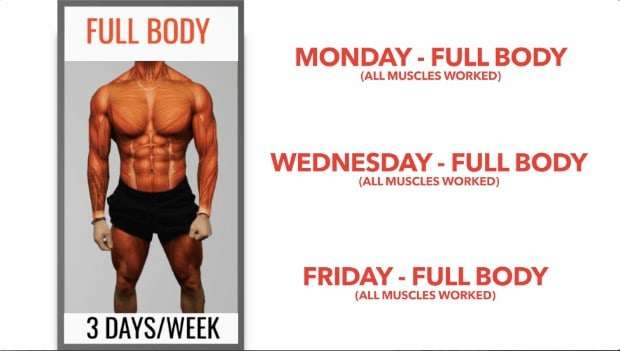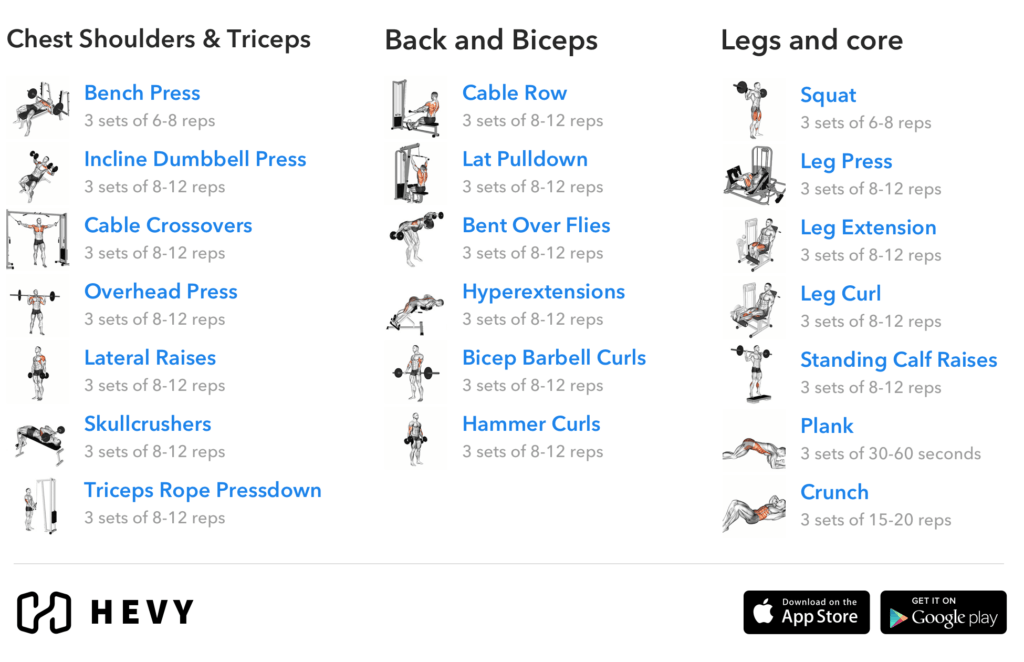So, you’ve decided to take your fitness routine to the next level and start a three-day workout split. But wait, there’s one question lingering in your mind – what is the ideal muscle group workout split for a 3-day routine? Well, fret no more, because in this article, we will break down the different muscle group splits and help you find the perfect balance for your three-day workout schedule. Whether you’re a beginner or a seasoned fitness enthusiast, we’ve got you covered with practical tips and expert advice. Let’s jump right in and discover the ultimate muscle group workout split for a three-day routine!
Benefits of a 3-Day Workout Routine
When it comes to workout routines, finding one that fits your schedule and lifestyle is essential. A 3-day workout routine is a popular choice for many individuals who want to stay fit and active but have limited time to dedicate to the gym. This type of routine offers numerous benefits that make it an effective and efficient option for those looking to maintain their fitness levels. In this article, we will explore the benefits of a 3-day workout routine and discuss how it can help you achieve your fitness goals.
Efficiency and Time Management
One of the main benefits of a 3-day workout routine is its efficiency. With only three days dedicated to working out, you can make the most of your time in the gym by focusing on compound exercises that target multiple muscle groups at once. This approach allows you to maximize your workout and get the most bang for your buck.
Additionally, a 3-day workout routine is perfect for individuals with busy schedules who struggle to find the time for longer gym sessions. By condensing your workouts into three days, you free up more time for other commitments while still maintaining a consistent exercise routine.
Adequate Rest and Recovery
Another significant advantage of a 3-day workout routine is the ample time it provides for rest and recovery. Unlike more demanding workout schedules, such as those that require daily workouts or working out the same muscle groups on consecutive days, a 3-day routine allows for adequate rest between sessions.
Rest and recovery are crucial for muscle growth and repair. When you exercise, you create micro-tears in your muscles, and it is during the rest period that your body rebuilds and strengthens those muscles. By giving yourself enough recovery time, you can ensure that your muscles have the opportunity to repair and grow stronger, leading to better results in the long run.
Factors to Consider for an Ideal Muscle Group Workout Split
Before diving into the different types of workout splits for a 3-day routine, it is essential to consider a few factors that will help you determine the ideal muscle group workout split for your needs. These factors include your goals and fitness level, time availability, and preference and enjoyment.
Goals and Fitness Level
The first factor to consider when determining the ideal muscle group workout split for a 3-day routine is your goals and fitness level. If your goal is to build strength and increase muscle size, you may benefit from a split that focuses on targeting specific muscle groups more intensely. On the other hand, if your goal is to improve overall fitness and endurance, a split that incorporates full-body workouts may be more suitable.
Your fitness level is also an important consideration. If you are a beginner or new to working out, it is generally advised to start with a full-body workout split to allow your body to adapt to the exercise routine gradually. As you progress and become more experienced, you can experiment with different splits that target specific muscle groups.
Time Availability
Another factor to consider is your time availability. A 3-day workout routine is already a time-efficient option, but it is essential to evaluate how much time you can dedicate to each session. Some workout splits may require additional time and focus on specific muscle groups, while others may be more balanced and evenly distributed across all muscle groups.
It is crucial to choose a split that aligns with your time availability without feeling rushed or overwhelmed during your workout sessions. Remember, consistency is key, so it is better to choose a routine that you can stick to in the long term rather than one that is too time-consuming and unrealistic for your schedule.
Preference and Enjoyment
Last but not least, your preference and enjoyment should play a significant role in determining the ideal muscle group workout split for a 3-day routine. Working out should be something you look forward to, and finding a split that aligns with your preferences and provides enjoyment is crucial for long-term adherence.
Consider the types of exercises you enjoy the most and whether you prefer focusing on specific muscle groups or prefer a more balanced approach. Your workout routine should be something that you genuinely enjoy doing to ensure consistency and motivation in the long run.
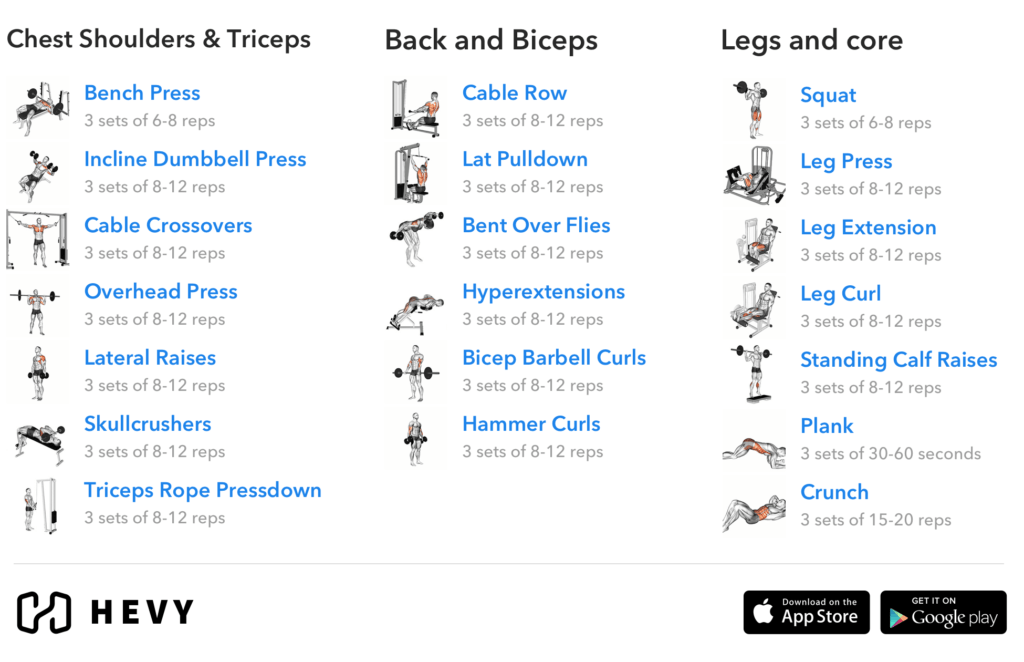
Different Types of Workout Splits
Now that we have discussed the factors to consider, let’s explore the different types of workout splits commonly used in a 3-day routine. These splits include full-body workouts, upper/lower splits, push/pull/legs splits, and body part splits. Each split has its own unique benefits and considerations, so let’s take a closer look at each one.
Full Body Workout
A full body workout split involves targeting all major muscle groups in a single workout session. This type of split is ideal for individuals who are short on time, beginners, or those who enjoy a balanced approach to their workouts. Full body workouts allow you to work multiple muscle groups in each session, maximizing efficiency and promoting overall strength and fitness.
Upper/Lower Split
The upper/lower split divides your workouts into upper body exercises and lower body exercises. This split allows for more targeted training of each muscle group, as you can focus on specific upper body muscle groups on one day and lower body muscle groups on another day. It offers a good balance between muscle group specialization and overall body training.
Push/Pull/Legs Split
The push/pull/legs split separates your workouts into three distinct groups: push exercises (such as chest, shoulders, and triceps), pull exercises (such as back and biceps), and leg exercises. This split allows you to target specific muscle groups more intensively while also providing adequate time for rest and recovery.
Body Part Split
A body part split involves focusing on one or two major muscle groups per workout session. For example, dedicating one session to chest and triceps, another session to back and biceps, and so on. This split allows for greater specialization and focus on individual muscle groups, making it beneficial for individuals who want to target specific areas or have specific aesthetic goals.
Choosing the Right Muscle Group Workout Split for a 3-Day Routine
Now that we are familiar with the different types of workout splits, let’s discuss how to choose the right one for a 3-day routine. When deciding on a split, there are several factors to consider.
Consideration of Goals and Fitness Level
First and foremost, consider your goals and fitness level. If your primary goal is overall fitness and strength, a full-body workout or upper/lower split may be the best options. These splits allow for a balanced approach and work well for individuals of all fitness levels.
If you have specific aesthetic goals or want to focus on building strength in particular muscle groups, the push/pull/legs split or body part split may be more suitable. These splits allow for more targeted training and specialization in specific areas.
Balancing Muscle Groups
Another important consideration is to ensure that your chosen split adequately balances the workload across all muscle groups. It’s essential to avoid neglecting any muscle group, as this can lead to imbalances and potential injuries. For example, if you choose a body part split, make sure to dedicate equal time and effort to all major muscle groups over the course of your weekly routine.
Training Frequency
Training frequency is also a crucial factor to consider. Depending on your goals and fitness level, you may benefit from training each muscle group once, twice, or three times per week. Training each muscle group multiple times per week can lead to greater muscle growth and strength gains, but it may require more time and effort. Consider your time availability and recovery abilities when determining the appropriate training frequency for your chosen split.
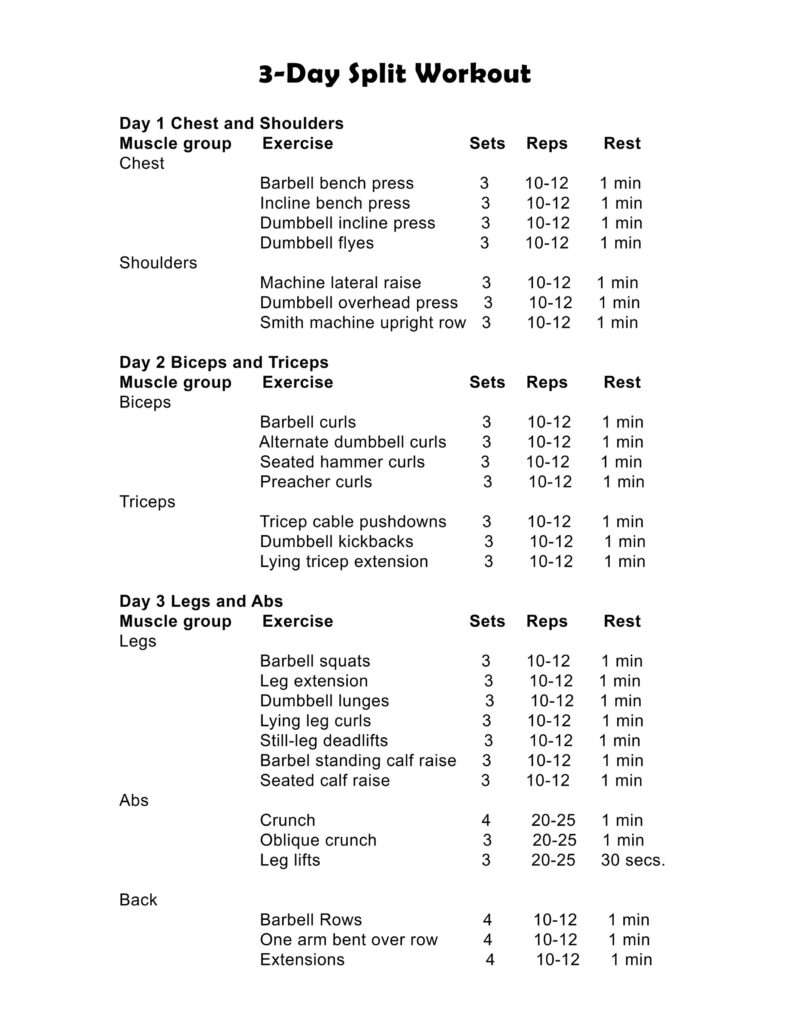
Example of Muscle Group Workout Split for a 3-Day Routine
To illustrate how these workout splits can be incorporated into a 3-day routine, let’s explore an example.
Day 1: Full Body Workout
On the first day, you can perform a full-body workout. This workout should include compound exercises that target all major muscle groups. Squats, bench presses, deadlifts, shoulder presses, and rows can be incorporated to work multiple muscle groups simultaneously.
Day 2: Upper/Lower Split
On the second day, you can focus on an upper/lower split. For the upper body, include exercises such as bench press, shoulder press, pull-ups, rows, and tricep dips. For the lower body, incorporate squats, lunges, deadlift variations, and calf raises.
Day 3: Push/Pull/Legs Split
On the third day, you can follow a push/pull/legs split. For the push exercises, include exercises such as bench press, shoulder press, tricep pushdowns, and chest flies. For the pull exercises, incorporate pull-ups, rows, bicep curls, and lat pulldowns. For the leg exercises, include squats, lunges, deadlift variations, and calf raises.
Day 1: Full Body Workout
Benefits of Full Body Workouts
Full body workouts offer several benefits. Firstly, they allow you to work all major muscle groups in a single session, ensuring a balanced approach to your workout routine. This balanced approach promotes overall strength and fitness. Additionally, full body workouts are time-efficient, making them suitable for individuals with busy schedules.
Exercise Selection
When designing a full body workout, it is important to incorporate compound exercises that target multiple muscle groups. Squats, deadlifts, bench presses, shoulder presses, and rows are excellent exercises to include in a full body workout as they engage multiple muscle groups simultaneously.
Training Frequency
For a 3-day routine, it is generally recommended to perform a full body workout once or twice a week. This allows for adequate recovery time between sessions while still providing enough stimulus for muscle growth and strength gains.
Sample Workout
Here is a sample full body workout for your 3-day routine:
- Squats: 3 sets of 8-10 reps
- Bench Press: 3 sets of 8-10 reps
- Deadlifts: 3 sets of 6-8 reps
- Shoulder Press: 3 sets of 8-10 reps
- Rows: 3 sets of 10-12 reps
- Bicep Curls: 3 sets of 10-12 reps
- Tricep Dips: 3 sets of 10-12 reps
- Plank: 3 sets, hold for 30-60 seconds
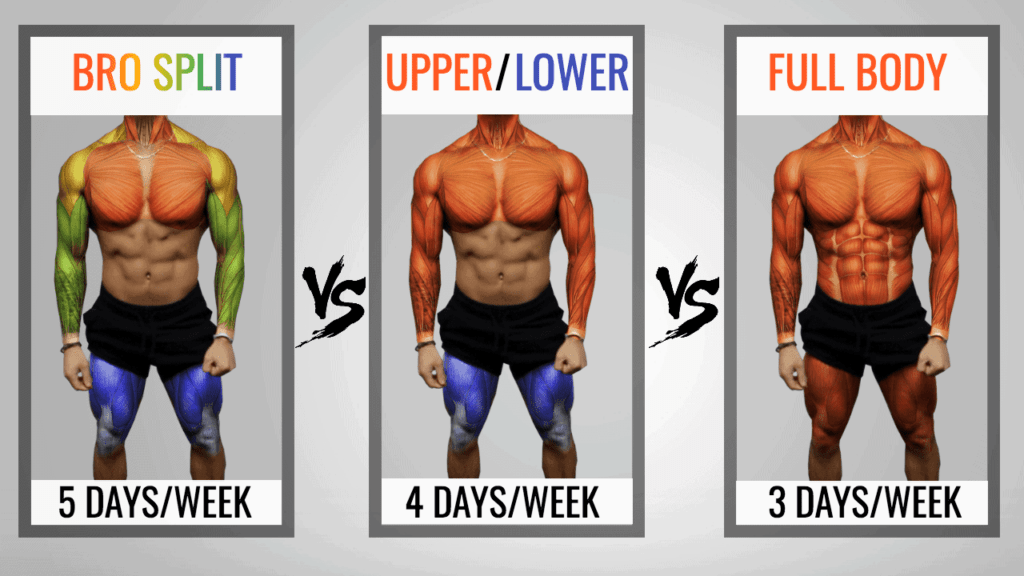
Day 2: Upper/Lower Split
Benefits of Upper/Lower Splits
Upper/lower splits offer several advantages. By targeting the upper and lower body separately, you can focus on specific muscle groups more intensively. This allows for greater specialization and can lead to improved strength and muscle growth. Additionally, upper/lower splits provide balance and symmetry by evenly distributing the workload across both the upper and lower body.
Exercise Selection
When creating an upper/lower split, it is important to select exercises that effectively target each muscle group. For the upper body, include exercises such as bench press, shoulder press, pull-ups, rows, and tricep dips. For the lower body, incorporate squats, lunges, deadlift variations, and calf raises.
Training Frequency
For a 3-day routine, it is generally recommended to perform upper/lower workouts twice a week, allowing at least 48 hours of rest between sessions. This frequency provides enough stimulus for muscle growth and recovery while preventing overtraining.
Sample Workout
Here is a sample upper/lower split workout for your 3-day routine:
Upper Body:
- Bench Press: 3 sets of 8-10 reps
- Shoulder Press: 3 sets of 8-10 reps
- Pull-Ups: 3 sets of 8-10 reps
- Rows: 3 sets of 10-12 reps
- Tricep Dips: 3 sets of 10-12 reps
Lower Body:
- Squats: 3 sets of 8-10 reps
- Lunges: 3 sets of 10-12 reps (each leg)
- Deadlifts: 3 sets of 6-8 reps
- Calf Raises: 3 sets of 12-15 reps
Day 3: Push/Pull/Legs Split
Benefits of Push/Pull/Legs Splits
Push/pull/legs splits offer several benefits. By dividing your workouts into push exercises, pull exercises, and leg exercises, you can target specific muscle groups more intensively. This allows for greater specialization and can lead to improved muscle growth and strength gains. Additionally, push/pull/legs splits ensure a well-balanced routine that evenly distributes workload across all muscle groups.
Exercise Selection
When incorporating a push/pull/legs split into your routine, include exercises that effectively target each muscle group. For the push exercises, include bench press, shoulder press, tricep pushdowns, and chest flies. For the pull exercises, incorporate pull-ups, rows, bicep curls, and lat pulldowns. For the leg exercises, include squats, lunges, deadlift variations, and calf raises.
Training Frequency
For a 3-day routine, it is generally recommended to perform push/pull/legs workouts twice a week, allowing at least 48 hours of rest between sessions. This frequency provides enough stimulus for muscle growth and recovery while preventing overtraining.
Sample Workout
Here is a sample push/pull/legs split workout for your 3-day routine:
Push:
- Bench Press: 3 sets of 8-10 reps
- Shoulder Press: 3 sets of 8-10 reps
- Tricep Pushdowns: 3 sets of 10-12 reps
- Chest Flies: 3 sets of 10-12 reps
Pull:
- Pull-Ups: 3 sets of 8-10 reps
- Rows: 3 sets of 10-12 reps
- Bicep Curls: 3 sets of 10-12 reps
- Lat Pulldowns: 3 sets of 10-12 reps
Legs:
- Squats: 3 sets of 8-10 reps
- Lunges: 3 sets of 10-12 reps (each leg)
- Deadlifts: 3 sets of 6-8 reps
- Calf Raises: 3 sets of 12-15 reps
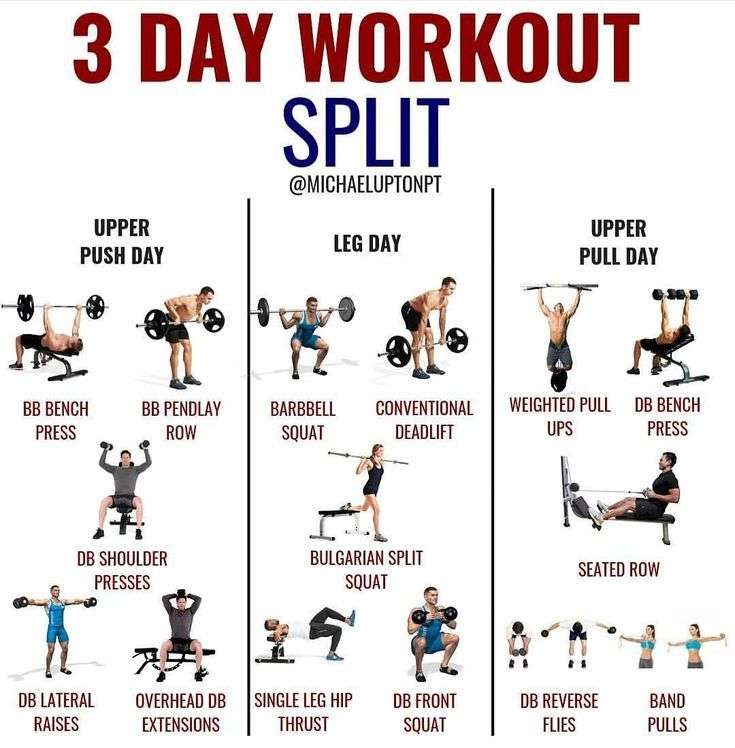
Common Mistakes to Avoid
While following a 3-day workout routine, there are some common mistakes you should avoid to maximize your results and prevent injuries.
Neglecting Recovery
Even though a 3-day routine allows for ample rest and recovery, it is still essential to prioritize proper recovery strategies. Make sure to get enough sleep, fuel your body with nutritious food, and listen to any signs of overtraining or fatigue. Remember, progress is made during rest, so neglecting recovery can hinder your progress and increase the risk of injuries.
Imbalance in Muscle Groups
Another common mistake is neglecting certain muscle groups or overemphasizing others. It is important to maintain balance by working all major muscle groups equally. Neglecting certain muscle groups can lead to muscle imbalances and increase the risk of injuries. Make sure to incorporate exercises that target all major muscle groups in your chosen workout split.
Overcomplicating the Routine
Lastly, it is important to keep your workout routine simple and manageable. Avoid overcomplicating your routine with too many exercises or sets. Focus on quality over quantity and choose exercises that effectively target your desired muscle groups. With a 3-day routine, it is crucial to make the most of your limited time and focus on the exercises that will provide the most benefit.
Conclusion
A 3-day workout routine offers numerous benefits such as efficiency, time management, and adequate rest and recovery. When determining the ideal muscle group workout split for this routine, consider your goals and fitness level, time availability, and preference and enjoyment. By choosing the right split, balancing muscle groups, and considering training frequency, you can create an effective and sustainable workout routine.
Remember, there are different types of workout splits to choose from, including full body workouts, upper/lower splits, push/pull/legs splits, and body part splits. Each split has its own unique benefits and considerations, so it is important to choose one that aligns with your goals and preferences.
To maximize your results and prevent any common mistakes, prioritize recovery, maintain balance in your routine, and avoid overcomplicating your workouts. With consistency and dedication, a 3-day workout routine can help you achieve your fitness goals and maintain a healthy and active lifestyle.
